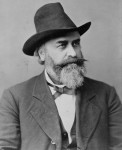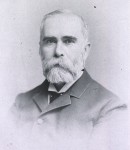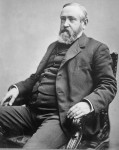John Harrison, still in shock, recovered his wits as best he could and sent for Cincinnati undertakers Estep & Meyer to remove his father’s body and keep it in ice until reburial could be arranged. That very evening, John Scott Harrison would be temporarily reinterred at the Spring Grove Cemetery in Cincinnati in the family vault of the Harrisons’ close friend Jacob Strader. John and George Eaton set out for North Bend to tell their family the dreadful news.
 Meanwhile, relatives visiting John Scott Harrison’s grave that morning found that it had been robbed. The stones at the foot of the coffin had been shifted onto their side, the foot of the coffin drilled into, the lid pried up and its glass cover broken, the body roped around the feet and pulled through the broken glass out of the grave. Usually resurrectionists broke into the top the coffin because it was easier to pull a body out by the arms, so it seems the ghouls must have been present at the burial or learned of the additional security measures taken by the Harrisons after they discovered Augustus Devin’s body had been snatched and therefore knew that their best chance was at the foot of the coffin where the smaller stones had been placed. Benjamin Harrison later recalled having been jostled by an unknown man at the burial site who got right up to the edge of the grave and looked inside with interest.
Meanwhile, relatives visiting John Scott Harrison’s grave that morning found that it had been robbed. The stones at the foot of the coffin had been shifted onto their side, the foot of the coffin drilled into, the lid pried up and its glass cover broken, the body roped around the feet and pulled through the broken glass out of the grave. Usually resurrectionists broke into the top the coffin because it was easier to pull a body out by the arms, so it seems the ghouls must have been present at the burial or learned of the additional security measures taken by the Harrisons after they discovered Augustus Devin’s body had been snatched and therefore knew that their best chance was at the foot of the coffin where the smaller stones had been placed. Benjamin Harrison later recalled having been jostled by an unknown man at the burial site who got right up to the edge of the grave and looked inside with interest.
The watchman hired to guard the grave was considered a prime suspect, as were other characters in North Bend who were suspected of association with grave robbers. The guard claimed he had not in fact watched the grave, that he was spooked by being in a cemetery at night and had stayed home instead. He did see a buggy rumbling by in the middle of the night, though, perhaps the very buggy that was later seen behind the Ohio Medical College making its gruesome delivery.
 George’s brother Arch Eaton and Carter Harrison went to Cincinnati to notify their brothers of this latest outrage. When they met at the train depot, Carter told John that their father’s body had been snatched and John told Carter that he already knew because he had found it. They sent a dispatch to their brother Benjamin in Indianapolis informing him of the theft and recovery of their father’s body. Benjamin immediately telegraphed famed detective agency head Allan Pinkerton telling him to come in person or send his best detectives to Cincinnati stat, then got on the first train reaching Cincinnati at 10:00 PM.
George’s brother Arch Eaton and Carter Harrison went to Cincinnati to notify their brothers of this latest outrage. When they met at the train depot, Carter told John that their father’s body had been snatched and John told Carter that he already knew because he had found it. They sent a dispatch to their brother Benjamin in Indianapolis informing him of the theft and recovery of their father’s body. Benjamin immediately telegraphed famed detective agency head Allan Pinkerton telling him to come in person or send his best detectives to Cincinnati stat, then got on the first train reaching Cincinnati at 10:00 PM.
The Harrisons already in Cincinnati wasted no time either. Carter Harrison went to a justice of the peace and swore an affidavit against the janitor for receiving and concealing the unlawfully disinterred body of their father. Based on the affidavit, an arrest warrant was issued for Mr. Marshall and he was thrown in jail. Within a week he was out on $5,000 bond paid for by faculty of the medical college.
Although the family attempted to keep the horror secret, it was front page news by the next day. William Henry Harrison was the first president from Ohio and he was revered in the state. The desecration of his son’s grave was an affront to the beloved late president as well as to the body and memory of the popular two-term Congressman himself. The Ohio Medical College was pilloried in the media. There was rampant speculation that the college had actually commissioned the resurrection of John Scott Harrison because his death was so sudden and unexplained that he would make an excellent subject for anatomical exploration.
 Members of the college faculty denied that charge strenuously and expressed dismay that they had been caught with the body of so illustrious a personage instead of the typical friendless paupers who didn’t have anybody looking out for them, but they had to have cadavers for dissection or else their graduates would be barraged with malpractice lawsuits for being terrible at basic anatomy and surgery. Dr. William Wallace Seely, professor and Secretary of the Medical College, told the Cincinnati Enquirer “had we known whose body it was that was suspended on that rope, we would have returned it to its grave and said nothing about it. It is true we must have bodies to work on, but it is not politic to run such risks, and we are not in favor of such desecration as that practiced in this instance.” As for the resurrectionist responsible, Seeley claimed they had no idea who it was because they were usually paid the day after the surreptitious nighttime deliveries, and the huge outcry after the discovery of John Scott Harrison’s body must have kept the body-snatcher from claiming his price.
Members of the college faculty denied that charge strenuously and expressed dismay that they had been caught with the body of so illustrious a personage instead of the typical friendless paupers who didn’t have anybody looking out for them, but they had to have cadavers for dissection or else their graduates would be barraged with malpractice lawsuits for being terrible at basic anatomy and surgery. Dr. William Wallace Seely, professor and Secretary of the Medical College, told the Cincinnati Enquirer “had we known whose body it was that was suspended on that rope, we would have returned it to its grave and said nothing about it. It is true we must have bodies to work on, but it is not politic to run such risks, and we are not in favor of such desecration as that practiced in this instance.” As for the resurrectionist responsible, Seeley claimed they had no idea who it was because they were usually paid the day after the surreptitious nighttime deliveries, and the huge outcry after the discovery of John Scott Harrison’s body must have kept the body-snatcher from claiming his price.
 On Saturday, June 1st, Dr. Roberts Bartholow, Dean of the Faculty of the Medical College of Ohio, who was intimately familiar with medical malpractice (having killed a poor “feeble-minded” Irish servant named Mary Rafferty in 1874 by inserting electrodes an inch and a half through her dura mater to study involuntary responses to electrical stimulation of the brain), published a statement in the Cincinnati Times. He opened with a masterwork of passive voice non-apology: “The Faculty of the Medical College of Ohio, in common with the rest of the community, heard with deep regret that the grave of the Hon. J. Scott Harrison had been violated, and that the body of this eminent and respected citizen had been found in the Medical College building.” Lukewarm sympathies expressed, he moved on to the justifications.
On Saturday, June 1st, Dr. Roberts Bartholow, Dean of the Faculty of the Medical College of Ohio, who was intimately familiar with medical malpractice (having killed a poor “feeble-minded” Irish servant named Mary Rafferty in 1874 by inserting electrodes an inch and a half through her dura mater to study involuntary responses to electrical stimulation of the brain), published a statement in the Cincinnati Times. He opened with a masterwork of passive voice non-apology: “The Faculty of the Medical College of Ohio, in common with the rest of the community, heard with deep regret that the grave of the Hon. J. Scott Harrison had been violated, and that the body of this eminent and respected citizen had been found in the Medical College building.” Lukewarm sympathies expressed, he moved on to the justifications.
“A very great misconception seems to exist as regards the part taken by the Faculty and their assistants in procuring the material for dissection. The men engaged in the business of procuring subjects are, of course, unknown to the Faculty; they bring the material to the college, receive the stipulated price, and disappear as mysteriously as they came. In the case of the body of the Hon. J. Scott Harrison, it seems to have been brought by the resurrectionist on his own responsibility, and the poor janitor, whom it is sought to punish, had no part in, or knowledge of, the transaction.”
Bartholow did not say how the body came to be hoisted up the chute and then hidden there during the search of the college, nor why it had even occurred to them to hide it if they had no idea it wasn’t harvested from an unclaimed pauper’s grave, as allowed by law (with conditions). The janitor denied hoisting the body. None of the faculty copped to it. And they all insisted that they had no idea who the resurrectionist was.
 Unimpressed by an explanation in which somehow nobody at the school had anything to do with the body found hanging in its cadaver elevator shaft or the slightest notion of who sold it to them, Benjamin Harrison came in like a wrecking ball. He printed the family’s anguished and furious rebuttal in an open letter to the citizens of Cincinnati that afternoon. He started with a heartfelt expression of thanks for their support and a wish that “God keep your precious dead from the barbarous touch of the grave robber, and you from that taste of hell which comes with the discovery of a father’s grave robbed and the body hanging by the neck like that of a dog, in the pit of a medical college.”
Unimpressed by an explanation in which somehow nobody at the school had anything to do with the body found hanging in its cadaver elevator shaft or the slightest notion of who sold it to them, Benjamin Harrison came in like a wrecking ball. He printed the family’s anguished and furious rebuttal in an open letter to the citizens of Cincinnati that afternoon. He started with a heartfelt expression of thanks for their support and a wish that “God keep your precious dead from the barbarous touch of the grave robber, and you from that taste of hell which comes with the discovery of a father’s grave robbed and the body hanging by the neck like that of a dog, in the pit of a medical college.”
“We have been offered through the press the sympathy of the distinguished men who constitute the faculty of the Ohio Medical College. I have no satisfactory evidence that any of them knew whose body they had, but I have the most convincing evidence that they are covering the guilty scoundrel. While they consent to occupy this position, their abhorrence is a pretense, and their sympathy is cant and hypocrisy.
Who can doubt that if the officers of that institution had desired to secure the arrest of the guilty party, it would have been accomplished before night on Thursday? The bodies brought there are purchased and paid for by an officer of the college. The body snatcher stands before him and takes from his hand the fee for his hellish work. He is not an occasional visitant. He is often there, and it is silly to say that he is an unknown. After being tumbled like dung into that chute by the thief, some one inside promptly elevates the body by a windlass to the dissecting room. Who did it, gentlemen of the faculty?
Your janitor denied that it laid upon your tables, but the clean incision into the carotid artery, the thread with which it was ligatured, the injected veins, prove him a liar. Who made that incision and injected that body, gentlemen of the faculty? The surgeons who examined his work say that he was no bungler. While he lay upon your table, the long white beard, which the hands of infant grandchildren had often stroked in love, was rudely shorn from his face. Have you so little care of your college that an unseen and an unknown man may do all this? Who took him from that table and hung him by the neck in the pit?”
As for the claim that the resurrectionist was entirely unknown to the faculty, Harrison knew that was false because he had been told by a sympathetic faculty member that despite his direct denials in the press, Dr. Seely knew the name of the likely grave-robber and was willing to relay that information to Harrison. When Benjamin Harrison and the unnamed faculty member went to see Dr. Seely, however, he refused to speak the name, afraid that he’d get in trouble since he had no conclusive proof that this person had actually committed the crime. Seely had the balls to ask Harrison for legal advice on what his rights and responsibilities were in this situation, and Benjamin, while declining to act as a legal advisor, to his credit told the doctor that if he was criminally complicit in any aspect of the case, he should not say anything about it to him, but that if he wasn’t involved, he should tell all. Seely chose silence.
This only heightened Benjamin’s suspicions of the faculty. He was sure they had gotten to Seely before he had and convinced him to be quiet or risk criminal charges. On June 3rd, Benjamin and John Harrison and Bernard Devin, Augustus’ older brother, returned to the Medical College for an even more in-depth search. This time they brought the Pinkerton detective and a reporter as well as Col. Snelbaker and multiple police officers. Again, they found no trace of Augustus Devin’s body, but they did find the clothes John Scott Harrison had been buried in jammed between the rafters of the ceiling.
Benjamin Harrison told the press: “This is an emphatic denial of the janitor’s story that the body was not taken out of the shaft by attaches of the College. It was taken out and stripped and then, when we put upon the track, it was placed in the shaft to avoid detection.”
The discovery of the clothes confirmed Benjamin’s belief that the Medical College officers were in this up to their necks. He was convinced they had specifically ordered the robbing of his father’s grave and was resolved to see the guilty parties on the faculty charged with the crime instead of just their patsy janitor. While he got his lawyer on and took it to the grand jury, other Harrisons, Devins, the Pinkerton detective and Col. Snelbaker would continue the search for Augustus Devin and for the elusive resurrectionist who had dug up the body of John Scott Harrison.